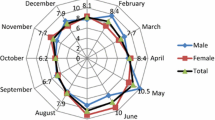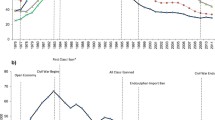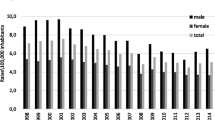Abstract
Background
Attempted suicide is a key predictor of suicide, which is among the dominant causes of young people’s deaths worldwide. Very little is known about the characteristics of suicide attempters in Asia, especially in Vietnam.
Methods
Medical records of 509 patients (515 attempted-suicide events) admitted to Bach Mai General Hospital in Hanoi, Vietnam from 1 January 1999 to 30 April 2001 were analysed according to the criteria of the WHO Multicentre Study of Attempted Suicide.
Results
The suicide attempters’ mean age was 28.3±12.9 years. Nearly half (48.7%) were aged 15–24. The female-to-male ratio of patients living in urban areas (2.1:1) was higher than in rural areas (1.2:1). In urban areas, students (32 %) and homeworkers (28%) and, in rural areas, farmers (56 %) and students (17%) were the salient occupational categories. Acute life stressors were the main causes (73.8%) of suicide attempts. Only in some 6% of cases had a psychiatric illness been diagnosed before the suicide attempts. As a means of attempting suicide, intoxication with analgesics and antipyretics (e. g. paracetamol) with low medical lethality scores was a frequent method among the urban patients, the majority of whom (81%) consequently stayed in hospital less than 24 h. Pesticide and rat poison, more commonly (57.2%) used by attempters in rural areas, had higher medical lethality scores and also necessitated more prolonged hospital treatment.
Conclusions
Some suicide-preventive strategies used in the West for young people may be applicable in Vietnam. Reducing access to pesticides and rat poison is comparable to western efforts to make paracetamol or firearms less freely available. Skills in resolving family and other conflicts can be taught in schools according to WHO’s suicide-prevention resources for teachers.
Similar content being viewed by others
References
WHO World Health Report 2001 (2001) Geneva: WHO
Wasserman D (ed) (2001) Suicide: an Unnecessary Death. London: Martin Dunitz
WHO World Report on Violence and Health (2002) Geneva: WHO
Ministry of Health (2000) Yearbook of Health Statistics. Hanoi: Medical Publishing House (in Vietnamese)
Adityanjee DR (1986) Suicide attempts and suicides in India: cross-cultural aspects. Int J Soc Psychiatry 32:64–73
Chiu LP (1989) Attempted suicide in Hong Kong. Acta Psychiatr Scand 79:425–430
Pan PC, Lieh-Mak F (1989) A comparison between male and female parasuicides in Hong Kong. Soc Psychiatry Psychiatr Epidemiol 24:253–257
Wai BH, Hong C, Heok KE (1999) Suicidal behavior among young people in Singapore. Gen Hosp Psychiatry 21:128–133
Retterstøl N, Mehlum L (2001) Attempted suicide as a risk factor for suicide: treatment and flow-up. In:Wasserman D ed. Suicide: an Unnecessary Death. London: Martin Dunitz, pp 125–132
Schmidtke A, Bille-Brahe U, et al. (1996) Attempted suicide in Europe: rates, trends and sociodemographic characteristics of suicide attempters during the period 1989–1992. Results of the WHO/EURO Multicentre Study on Parasuicide. Acta Psychiatr Scand 93:327–338
Hjelmeland H, Nordvik H, et al. (2000) A cross-cultural study of suicide intent in parasuicide patients. Suicide Life Threat Behav 30:295–303
Beautrais AL (2001) Suicides and serious suicide attempts: two populations or one? Psychol Med 31:837–845
Beck AT, Beck R, Kovacs M (1975) Classification of suicidal behaviors: I.Quantifying intent and medical lethality. Am J Psychiatry 132:285–287
Ramberg IL, Wasserman D (2000) Prevalence of reported suicidal behaviour in the general population and mental health-care staff. Psychol Med 30:1189–1196
Beautrais AL, Joyce PR, Mulder RT (1998) Unemployment and serious suicide attempts. Psychol Med 28:209–218
WHO (2000) Department of Mental Health. Preventing suicide: a resource for teachers and other school staff. Geneva: WHO
Wasserman D, Narboni V (2001) Guidelines for suicide prevention in schools. National Centre for Suicide Research and Prevention of Mental Ill-Health. Stockholm, pp 1–95
Ostamo A, Lönnqvist J (2001) Attempted suicide rates and trends during a period of severe economic recession in Helsinki, 1989–1997. Soc Psychiatry Psychiatr Epidemiol 36:354–360
Pirkola S, Isometsa E, Heikkinen M, Lonnqvist J (1997) Employment status influences the weekly patterns of suicide among alcohol misusers. Alcohol Clin Exp Res 21:1704–1706
Garnefski N, Arends E (1998) Sexual abuse and adolescent maladjustment: differences between male and female victims. J Adolesc 21:99–107
Phillips MR, Yang G, Zhang Y, Wang L, Ji H, Zhou M (2002) Risk factors for suicide in China: a national case-control psychological autopsy study. Lancet 360:1728–1736
Leenaars A (2001) Controlling the environment to prevent suicide. In: Wasserman D (ed) Suicide: an Unnecessary Death. London: Martin Dunitz, pp 259–264
Persson ML, Runeson BS, Wasserman D (1999) Diagnoses, psychosocial stressors and adaptive functioning in attempted suicide. Ann Clin Psychiatry 11:119–128
Üstün TB, Kessler RC (2002) Global burden of depressive disorders: the issue of duration. Br J Psychiatry 181:181–183
Nielsen AS, Bille-Brahe U, Hjelmeland H, Jensen B, Ostamo A, Salander-Renberg E, Wasserman D (1996) Alcohol problems among suicide attempters in the Nordic countries. Crisis 17:157–166
Wasserman D, Varnik A (1998) Suicide-preventive effects of perestroika in the former USSR: the role of alcohol restriction. Acta Psychiatr Scand 394(Suppl):1–4
Vijayakumar L, Rajkumar S (1999) Are risk factors for suicide universal? A case-control study in India. Acta Psychiatr Scand 99:407–411
Teoh J (1974) An analysis of completed suicide by psychological post-mortem. Ann Acad Med Singapore 3:117–123
de Silva HJ, Kasturiaratchi N, Seneviratne SL, et al. (2002) Suicide in Sri Lanka: points to ponder. Ceylon Med J 45:17–24
Eddleston M, Sheriff MH, Hawton K (1998) Deliberate self harm in Sri Lanka: an overlooked tragedy in the developing world. BMJ 317:133–135
Wasserman D (1989) Passive euthanasia in response to attempted suicide: one form of aggressiveness by relatives. Acta Psychiatr Scand 79:460–467
Daradkeh TK (1992) Parasuicide during Ramadan in Jordan. Acta Psychiatr Scand 86:253–254
Author information
Authors and Affiliations
Rights and permissions
About this article
Cite this article
Thanh, H.T.T., Jiang, GX., Van, T.N. et al. Attempted suicide in Hanoi, Vietnam. Soc Psychiatry Psychiatr Epidemiol 40, 64–71 (2005). https://doi.org/10.1007/s00127-005-0849-6
Accepted:
Issue Date:
DOI: https://doi.org/10.1007/s00127-005-0849-6




